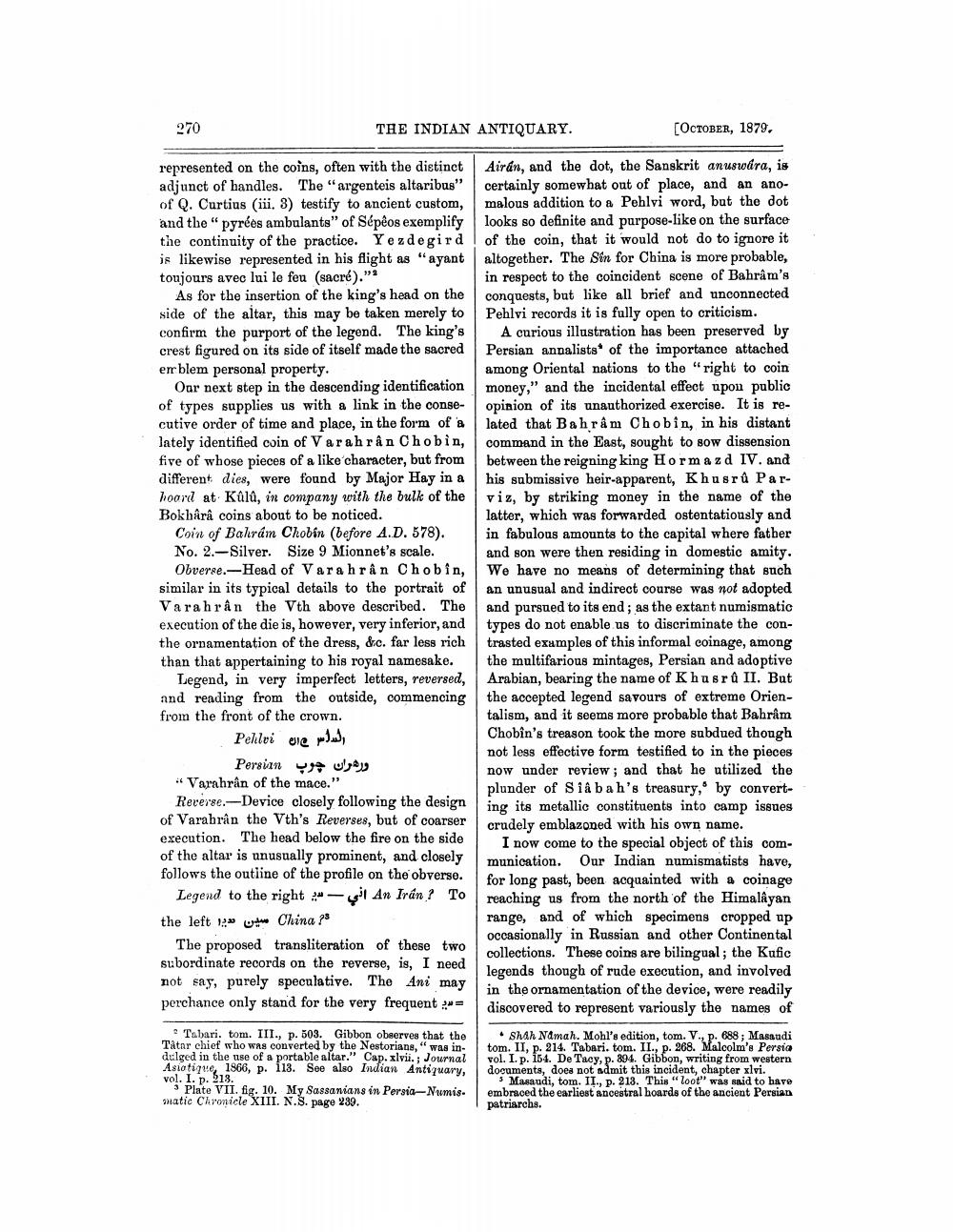________________
270
THE INDIAN ANTIQUARY.
[OCTOBER, 1879.
represented on the coins, often with the distinct adjunct of handles. The "argenteis altaribus" of Q. Curtius (iii. 3) testify to ancient custom, and the "pyrées ambulants" of Sépêos exemplify the continuity of the practice. Yezdegird is likewise represented in his flight as "ayant toujours avec lui le feu (sacré)."
As for the insertion of the king's head on the side of the altar, this may be taken merely to confirm the purport of the legend. The king's crest figured on its side of itself made the sacred er blem personal property.
Our next step in the descending identification of types supplies us with a link in the consecutive order of time and place, in the form of a lately identified coin of Varah rân Chobin, five of whose pieces of a like character, but from different dies, were found by Major Hay in a hoorl at Kûlû, in company with the bulk of the Bokhârâ coins about to be noticed.
Coin of Bahrám Chobin (before A.D. 578). No. 2.-Silver. Size 9 Mionnet's scale.
Obverse.—Head of Varah rân Chobin, similar in its typical details to the portrait of Varah rân the Vth above described. The execution of the die is, however, very inferior, and the ornamentation of the dress, &c. far less rich than that appertaining to his royal namesake.
Legend, in very imperfect letters, reversed, and reading from the outside, commencing from the front of the crown.
Airán, and the dot, the Sanskrit anuswara, is certainly somewhat out of place, and an anomalous addition to a Pehlvi word, but the dot looks so definite and purpose-like on the surface of the coin, that it would not do to ignore it altogether. The Sin for China is more probable, in respect to the coincident scene of Bahram's conquests, but like all brief and unconnected Pehlvi records it is fully open to criticism.
A curious illustration has been preserved by Persian annalists of the importance attached among Oriental nations to the right to coin money," and the incidental effect upon public opinion of its unauthorized exercise. It is related that Bah râm Chobin, in his distant command in the East, sought to sow dissension between the reigning king Hormazd IV. and his submissive heir-apparent, Khusru Parviz, by striking money in the name of the latter, which was forwarded ostentatiously and in fabulous amounts to the capital where father and son were then residing in domestic amity. We have no means of determining that such an unusual and indirect course was not adopted and pursued to its end; as the extant numismatic types do not enable us to discriminate the contrasted examples of this informal coinage, among the multifarious mintages, Persian and adoptive Arabian, bearing the name of Khusra II. But the accepted legend savours of extreme Orientalism, and it seems more probable that Bahram Chobin's treason took the more subdued though not less effective form testified to in the pieces now under review; and that he utilized the plunder of Sia bah's treasury, by converting its metallic constituents into camp issues crudely emblazoned with his own name.
I now come to the special object of this communication. Our Indian numismatists have, for long past, been acquainted with a coinage reaching us from the north of the Himalayan range, and of which specimens cropped up occasionally in Russian and other Continental collections. These coins are bilingual; the Kufic legends though of rude execution, and involved in the ornamentation of the device, were readily discovered to represent variously the names of
رنداس چورن Pellet
Persirn W wlyje · Varahrân of the mace."
Reverse. -Device closely following the design of Varabran the Vth's Reverses, but of coarser execution. The head below the fire on the side of the altar is unusually prominent, and closely follows the outline of the profile on the obverse.
Legend to the right - vil An Irán? To the left 13 with China ?
The proposed transliteration of these two subordinate records on the reverse, is, I need not say, purely speculative. The Ani may perchance only stand for the very frequent -
Tabari. tom. III., p. 503. Gibbon observes that the Tätnr chief who was converted by the Nestorians," was indulged in the use of a portable altar." Cap. xlvii.; Journal Asiatique, 1966, p. 113. See also Indian Antiquary, vol. I. p. 213.
3 Plate VII, fig. 10. My Sassanians in Persia-Numis. matic Chronicle XIII. N. S. page 239.
Shah Namah. Mohl's edition, tom. V., p. 688; Masaudi tom. II, p. 214. Tabari. tom. II., p. 268. Malcolm's Persia vol. I. p. 154. De Tacy, p. 894. Gibbon, writing from western documents, does not admit this incident, chapter xlvi.
Masaudi, tom. II., p. 213. This "loot was said to have embraced the earliest ancestral hoards of the ancient Persian patriarchs.




